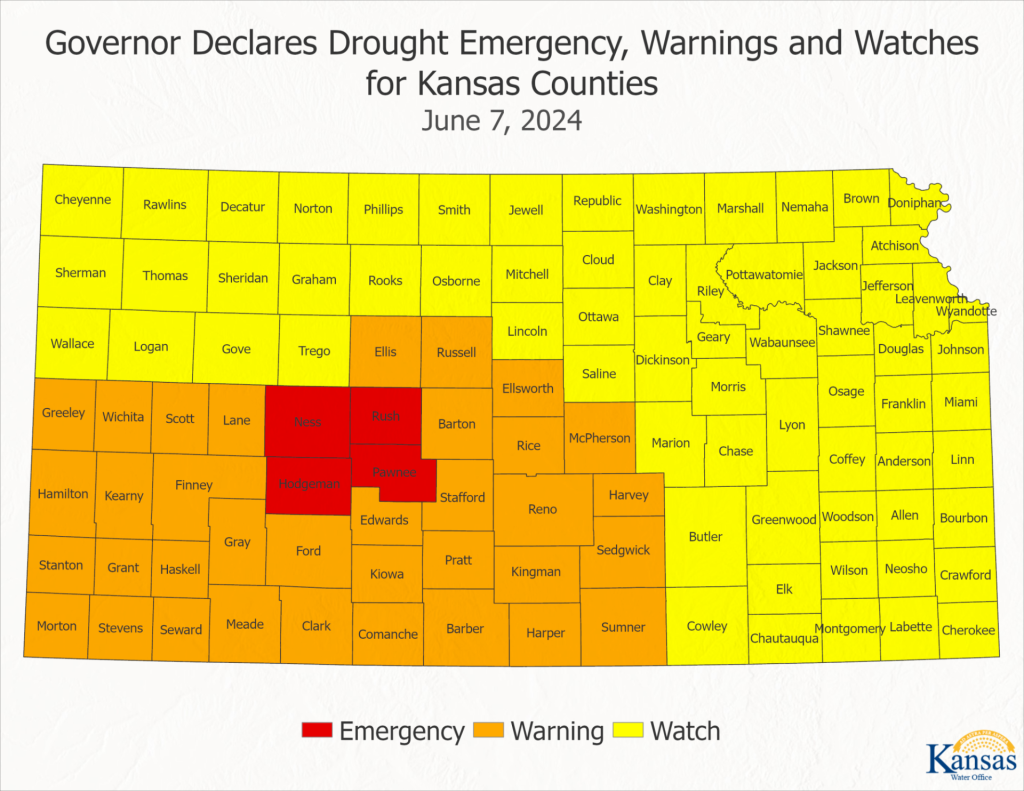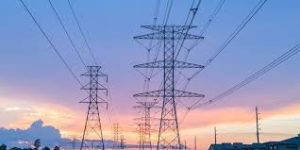Governor Kelly Updates Declaration of Drought Emergency, Warnings, and Watches for Kansas Counties

Topeka, Kan. (Kansas Water Office)–Governor Laura Kelly has approved updated drought declarations for Kansas counties through proclamation.
“While drought conditions have improved in some areas of the state, many counties continue to be negatively impacted by the decline in water supply or strains on water resources,” said Governor Laura Kelly. “I strongly encourage all Kansans to continue to conserve water over the summer months.”
The drought declaration placed four counties into emergency status, 35 into warning status, and 66 into watch status. This action was recommended by Connie Owen, Director of the Kansas Water Office and Chair of the Governor’s Drought Response Team. While Eastern Kansas has seen significant relief from drought since March, central and western Kansas has declined rapidly into Severe and, in a few counties, Extreme Drought.
“The counties in a watch status are experiencing conditions that indicate the probability of a water shortage is rising. It is important to monitor these conditions and be mindful of water usage in these counties,” said Owen. “Summer has arrived, and with it, higher temperatures and a decrease in precipitation. The Governor’s Drought Response Team will continue to monitor the drought conditions across Kansas and make recommendations to Governor Kelly as conditions change.”
Through an interagency agreement between the Kansas Water Office, the Kansas Department of Wildlife and Parks, and the Kansas Division of Emergency Management, counties in the emergency stage are eligible for emergency water use from certain state fishing lakes and some federal reservoirs.
Individuals and communities must contact the Kansas Water Office for a water supply request before any withdrawals from lakes. These requests will, in turn, be referred to the appropriate office to obtain necessary permits to withdraw the requested water.
This proclamation shall remain in effect for those counties identified until rescinded by a proclamation ending the declaration or revising the drought stage status of the affected counties.
Effective immediately, the proclamation declares a drought emergency, warning, or watch for the counties as identified below, and authorizes and directs all agencies under the jurisdiction of the Governor to implement the appropriate watch, warning, or emergency-level drought response actions assigned in the Operations Plan of the Governor’s Drought Response Team.
The Governor’s Drought Response Team will continue to watch the situation closely and work to minimize the negative drought-induced effects on Kansans.
For more detailed information about current conditions, visit the Climate and Drought webpage on the Kansas Water Office website at kwo.ks.gov.
Counties in a drought emergency are Hodgeman, Ness, Pawnee, Rush.
Counties in a drought warning include Barber, Barton, Clark, Comanche, Edwards, Ellis, Ellsworth, Finney, Ford, Grant, Gray, Greeley, Hamilton, Harper, Harvey, Haskell, Kearny, Kingman, Kiowa, Lane, McPherson, Meade, Morton, Pratt, Reno, Rice, Russell, Scott, Sedgwick, Seward, Stafford, Stanton, Stevens, Sumner, Wichita.
Counties in the drought watch are Allen, Anderson, Atchison, Bourbon, Brown, Butler, Chase, Chautauqua, Cherokee, Cheyenne, Clay, Cloud, Coffey, Cowley, Crawford, Decatur, Dickinson, Doniphan, Douglas, Elk, Franklin, Geary, Gove, Graham, Greenwood, Jackson, Jefferson, Jewell, Johnson, Labette, Leavenworth, Lincoln, Linn, Logan, Lyon, Marion, Marshall, Miami, Mitchell, Montgomery, Morris, Nemaha, Neosho, Norton, Osage, Osborne, Ottawa, Phillips, Pottawatomie, Rawlins, Republic, Riley, Rooks, Saline, Shawnee, Sheridan, Sherman, Smith, Thomas, Trego, Wabaunsee, Wallace, Washington, Wilson, Woodson, Wyandotte.










